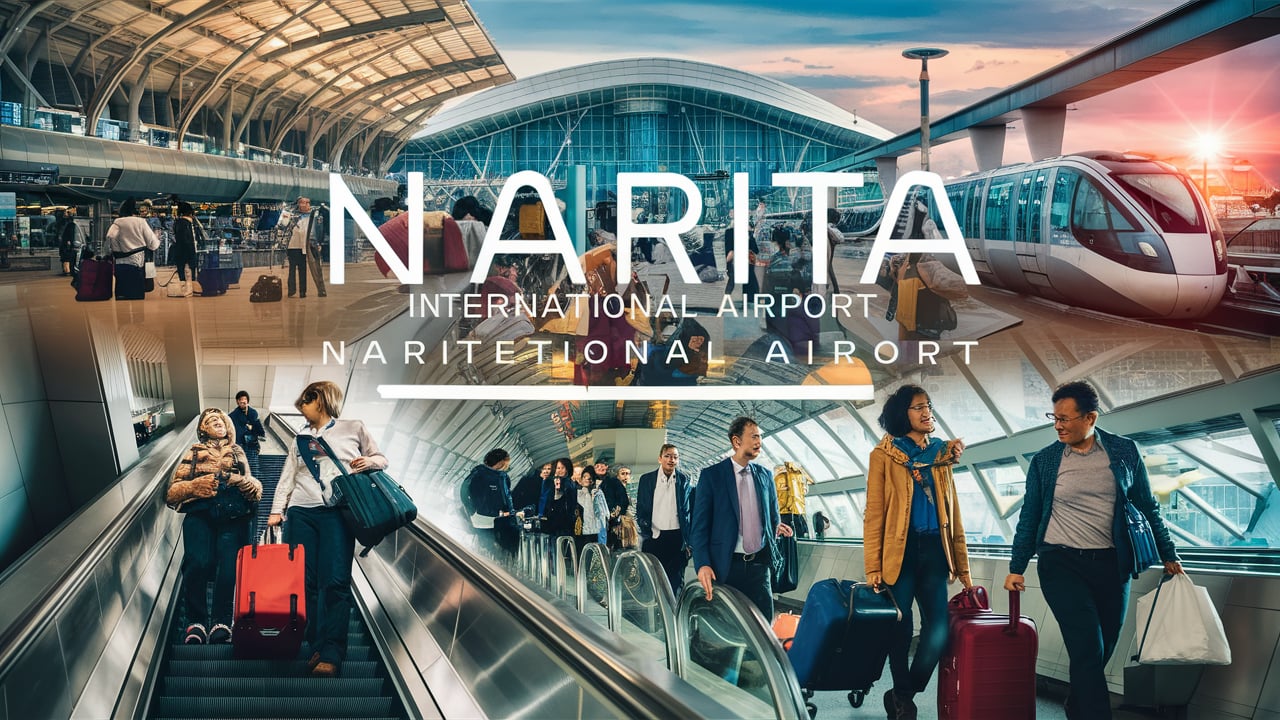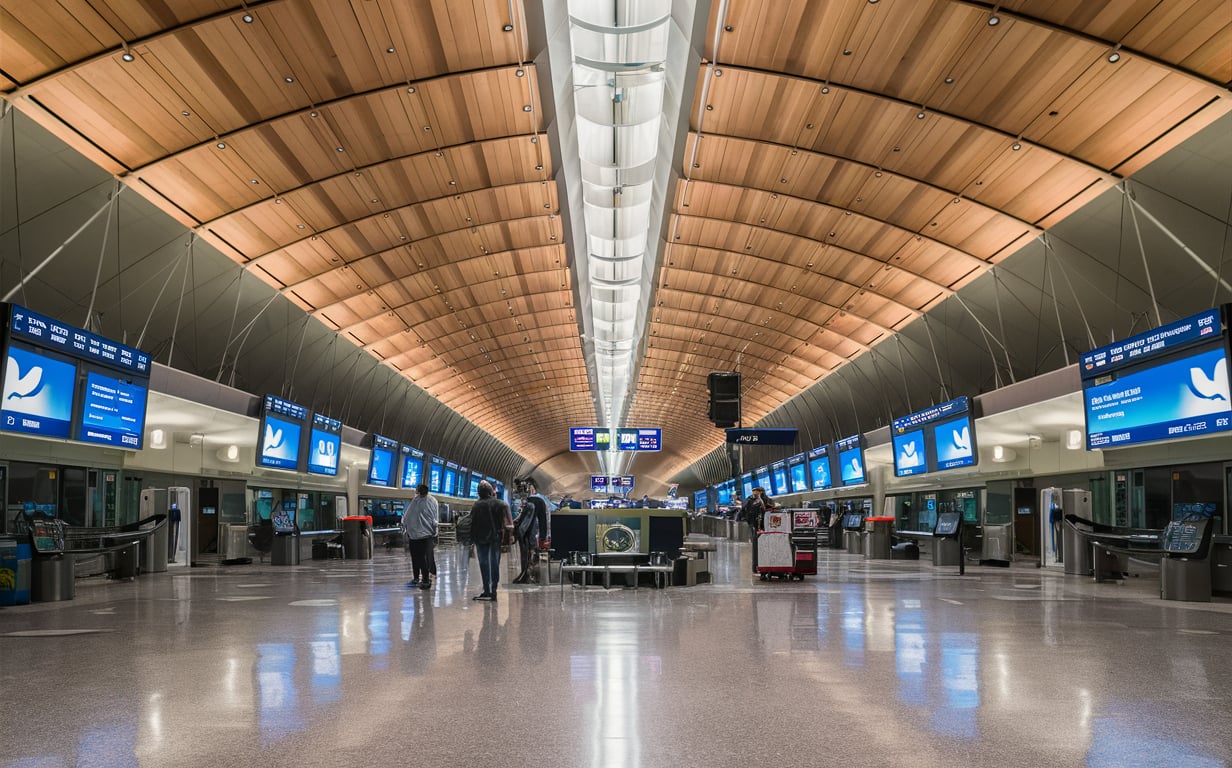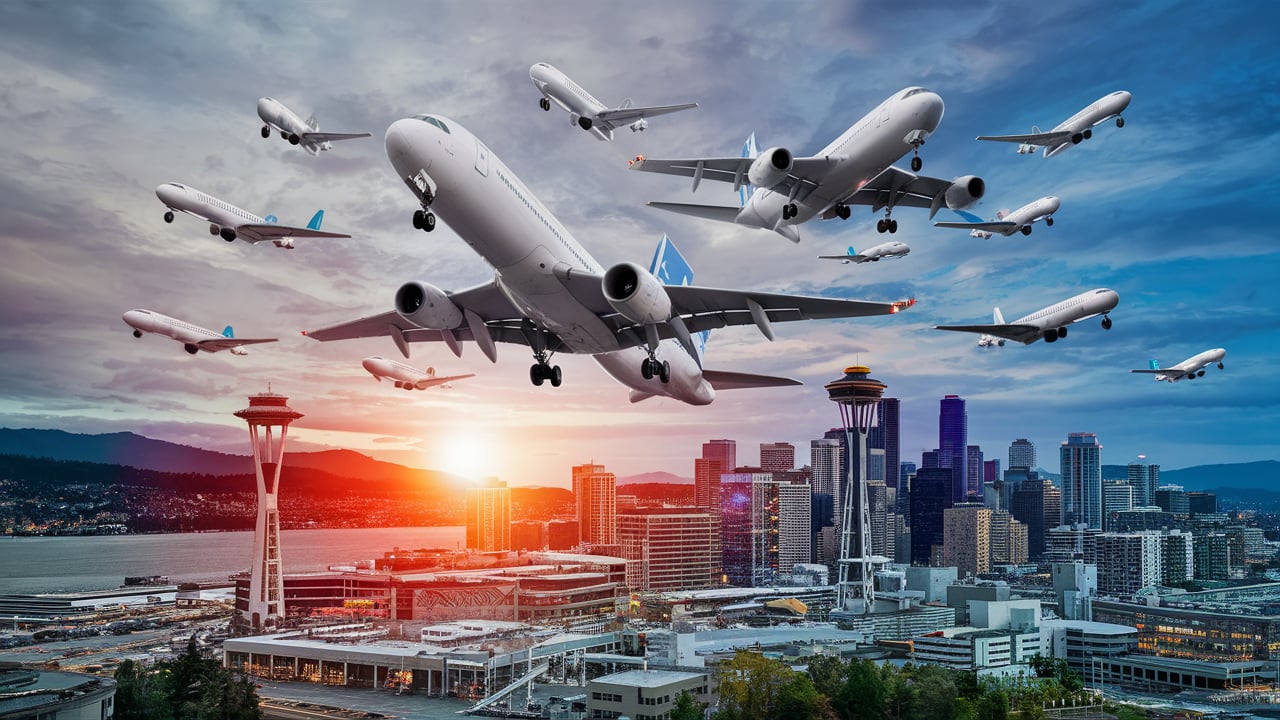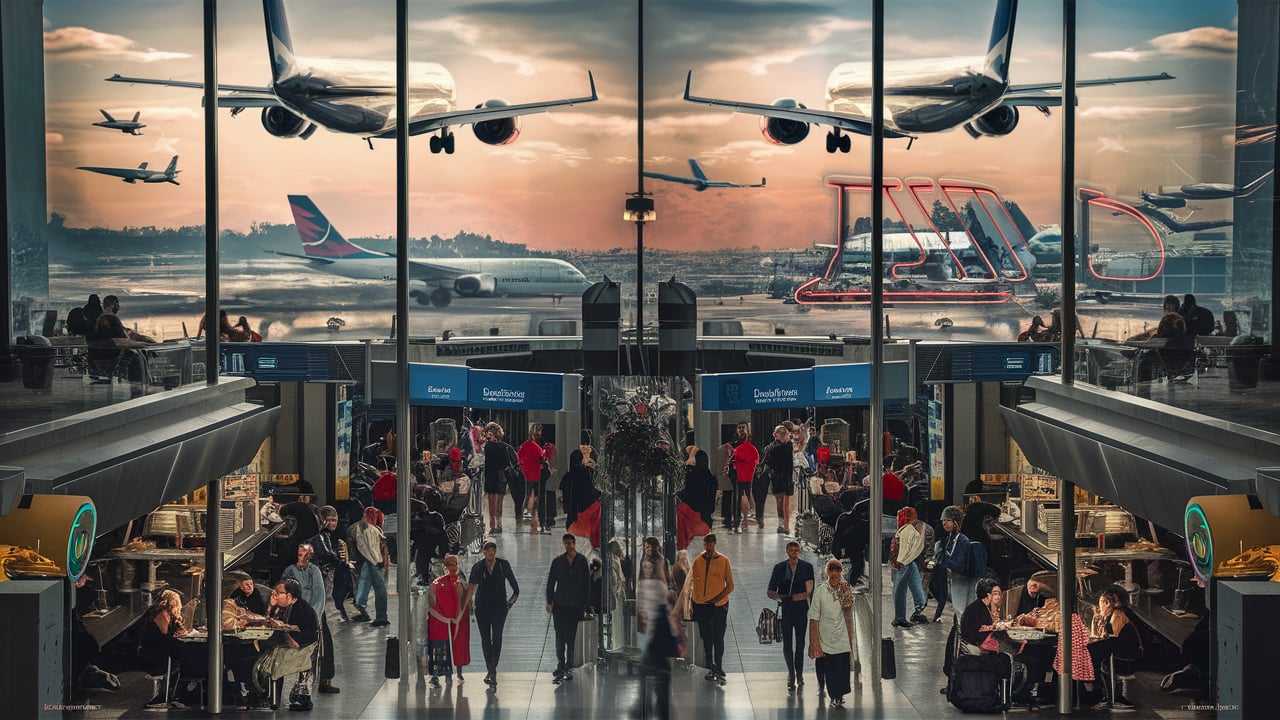Narita International Airport
Narita International Airport, located in Chiba Prefecture, approximately 60 kilometers east of Tokyo, is Japan’s second busiest airport after Tokyo’s Haneda. Since its opening in 1978, Narita has been the primary entry point for international travelers, welcoming millions each year.
The airport is celebrated not only as a transportation hub but also as a showcase of Japanese culture, merging advanced technology with traditional touches. Visitors often experience a taste of Japanese hospitality, or “omotenashi,” as soon as they step off the plane, with features like tatami-style seating areas, Japanese art installations, and authentic cuisine offerings scattered throughout the terminals.
Narita’s blend of functionality and cultural richness makes it a memorable starting point for exploring Japan’s vibrant capital and beyond.
Importance of Narita in Japan’s Transportation Network
Narita International Airport plays an essential role in Japan’s extensive transportation network. As the primary international airport for the Tokyo region, Narita connects Japan to major cities around the world, handling flights from every continent and serving as a key hub for long-haul travel. Beyond air travel, Narita’s connectivity with Japan’s land transportation network is exceptional, allowing seamless access to other parts of the country.
Travelers can easily catch trains like the Narita Express, which provides direct access to Tokyo Station in under an hour, or the Keisei Skyliner, which links to Ueno Station. From there, Japan’s famous Shinkansen bullet trains make it easy to explore destinations nationwide.
Additionally, numerous highway buses and limousine bus services connect Narita with various parts of Tokyo and nearby regions, catering to all types of travelers.
Quick Facts and Figures
Here’s an overview of some key details about Narita International Airport:
- Opened: 1978, designed as an international gateway to accommodate Japan’s growing inbound tourism.
- Location: 60 kilometers east of Tokyo, in Narita, Chiba Prefecture.
- Annual Passengers: Over 33 million passengers (pre-pandemic), underscoring its role as a global travel hub.
- Terminals: 3 (Terminals 1, 2, and 3) – each tailored for specific needs, including a terminal dedicated to budget airlines.
- Runways: 2 runways, supporting both domestic and international flights.
- Airlines Served: Narita is a major base for international airlines, hosting prominent carriers such as All Nippon Airways (ANA), Japan Airlines (JAL), Delta, and United, among others.
Terminal Overview
Narita International Airport has three terminals, each catering to different types of passengers:
- Terminal 1: Primarily serves major international airlines, including members of the Star Alliance. This terminal is known for its spacious design, variety of shopping and dining options, and efficient services for international passengers.
- Terminal 2: Home to OneWorld Alliance carriers like Japan Airlines, as well as other international flights. It’s well-equipped with facilities like lounges, restaurants, and duty-free shops, making it a convenient choice for international travelers.
- Terminal 3: Specially designed for low-cost carriers, Terminal 3 offers a more budget-friendly travel experience while still providing necessary amenities. Its unique warehouse-style design includes features such as color-coded walking paths to guide passengers, enhancing the ease of navigation.
Comparison with Tokyo’s Haneda Airport
Narita International Airport is often compared to Haneda Airport, Tokyo’s other major airport, located much closer to the city center. While both are essential to Tokyo’s air travel network, they serve slightly different purposes:
- Distance from Tokyo: Haneda is just 14 kilometers from central Tokyo, making it ideal for domestic flights and short-haul international routes. Narita, however, is 60 kilometers away, making it better suited for long-haul international flights.
- Flight Focus: Haneda’s focus is on domestic and short regional flights, while Narita is Japan’s primary hub for long-haul flights to North America, Europe, and other distant destinations.
- Facilities and Amenities: Narita is geared towards international travelers, with amenities such as multilingual information centers, duty-free shopping, currency exchange, and a greater variety of international dining options.
Despite the distance, Narita remains popular among travelers who value its extensive international network, robust amenities, and direct connections to Tokyo and other cities via rail and bus services. With Narita and Haneda working in tandem, Tokyo is well-equipped to handle the full spectrum of air travel needs, making Japan an accessible destination for visitors worldwide.
Location and How to Get There
Narita International Airport is located in Chiba Prefecture, about 60 kilometers (37 miles) east of Tokyo’s central districts. Despite being outside the Tokyo metropolitan area, Narita is well-connected to Tokyo’s city center and surrounding regions through a variety of transportation options that cater to different budgets, timeframes, and travel preferences. From fast trains to affordable bus options, travelers can choose the route that best suits their needs.
Distance from Central Tokyo
Narita’s distance from central Tokyo means that travel times can vary based on the mode of transportation chosen. The 60-kilometer journey can be completed in as little as 40 minutes via the fastest train options or can take up to 90 minutes by bus, depending on traffic conditions.
Travel Options: Train, Bus, Taxi, and Rental Car
Narita International Airport offers a variety of transportation options for all travel styles:
- Train: Narita is connected to central Tokyo by two main train services:
- Narita Express (N’EX): Operated by Japan Railways (JR), the Narita Express is a comfortable and direct option that connects the airport with major stations in Tokyo, including Tokyo Station, Shibuya, Shinjuku, and Yokohama. The N’EX takes about 60 minutes to Tokyo Station and is covered by the Japan Rail Pass, making it a great value for international tourists with the pass.
- Keisei Skyliner: This high-speed train connects Narita Airport to Ueno and Nippori Stations in just 41 minutes, making it the fastest train service to central Tokyo. It’s a popular choice for travelers staying in the Ueno or Asakusa areas. The Skyliner also offers convenient storage for luggage and a comfortable, efficient travel experience.
- Bus: The Airport Limousine Bus provides a direct, comfortable, and affordable option for those looking to travel directly to major Tokyo hotels and landmarks, such as Tokyo Station, Shinjuku, and Roppongi. Travel times vary depending on traffic, but the journey usually takes around 80-90 minutes. Additionally, some buses provide free Wi-Fi and ample luggage space.
- Taxi: While taxis are the most expensive travel option, they offer door-to-door service, making them ideal for travelers with a lot of luggage or those looking for convenience after a long flight. The one-way fare from Narita to Tokyo can range from ¥20,000 to ¥30,000 (approximately $150–$220), with a travel time of 60–90 minutes depending on traffic conditions.
- Rental Car: For travelers looking for flexibility and control over their journey, rental cars are available at Narita Airport. However, driving in Japan can be challenging for those unfamiliar with local road rules, as road signs are often in Japanese. Additionally, highway tolls and Tokyo’s dense traffic can add to travel time and expenses, so rental cars are recommended primarily for those planning to explore areas outside of central Tokyo.
Public Transportation Tips
Travelers looking to save money on transportation can consider budget-friendly options:
- Tokyo Shuttle and Access Narita Buses: These shuttle buses offer economical travel options between Narita Airport and Tokyo’s main transit hubs, with fares as low as ¥1,000–¥2,000 (approximately $7–$14) per trip.
- Japan Rail Pass: For international tourists planning to explore Japan, the Japan Rail Pass provides unlimited travel on JR trains, including the Narita Express. This pass is a cost-effective choice for those intending to visit multiple cities and can be used for travel to and from the airport.
Best Routes and Travel Times
When planning your journey, keep in mind that Tokyo’s rush hours (typically from 7:30–9:00 AM and 5:00–7:00 PM) can lead to crowded trains and heavy traffic, which may impact travel times. Mid-morning and late evening are generally the least crowded times for travel, ensuring a smoother experience on both trains and buses.
For speed and convenience, both the Narita Express and Keisei Skyliner are known for their punctuality and reliability. By choosing these services, travelers can enjoy a comfortable and efficient journey to Tokyo’s central districts, minimizing stress and maximizing the enjoyment of their arrival in Japan.
Navigating the Terminals
Narita International Airport is organized into three main terminals – Terminals 1, 2, and 3 – each with distinct features designed to serve different airline alliances and types of travelers. Understanding the layout and amenities of each terminal can make your journey through Narita smoother and more enjoyable.
Overview of Terminals 1, 2, and 3
Each terminal at Narita Airport is organized to accommodate specific airlines and passengers, ensuring a tailored experience:
- Terminal 1: This terminal mainly serves Star Alliance member airlines such as ANA (All Nippon Airways) and United Airlines. It’s equipped with a wide range of amenities, including several high-end lounges, numerous duty-free shops, and a variety of dining options from traditional Japanese cuisine to international fare. Travelers in Terminal 1 can also access direct train services, making it convenient for quick connections to Tokyo and other destinations.
- Terminal 2: Primarily used by OneWorld Alliance airlines, including Japan Airlines and American Airlines, Terminal 2 offers a similar array of amenities as Terminal 1. In addition to a robust selection of shops, restaurants, and lounges, Terminal 2 is well-connected to Narita’s train services, providing easy access to downtown Tokyo. This terminal is known for its efficiency in handling large volumes of international passengers.
- Terminal 3: Dedicated to low-cost carriers, Terminal 3 is ideal for budget-conscious travelers. It has a more streamlined design, with basic but essential facilities like fast food outlets, convenience stores, and seating areas for resting. While it may lack the extensive shopping and dining options found in Terminals 1 and 2, Terminal 3 still provides a comfortable and efficient experience for those traveling on a budget.
Facilities and Amenities in Each Terminal
Narita International Airport prioritizes passenger comfort and convenience, and each terminal is designed with facilities to enhance the travel experience:
- Dining and Shopping: Terminals 1 and 2 feature a wide variety of dining options, from casual food courts to more upscale restaurants. Passengers can enjoy authentic Japanese dishes, international cuisine, and a selection of fast-food options. Both terminals also have duty-free shops offering electronics, souvenirs, cosmetics, and luxury brands. Terminal 3 provides more limited choices but still includes essential dining and shopping outlets.
- Currency Exchange and ATM Services: Each terminal has multiple currency exchange counters and ATMs available, making it easy for international travelers to manage their finances upon arrival or departure.
- Lounges and Relaxation Spaces: Terminals 1 and 2 are equipped with several premium lounges for passengers seeking a quiet space to relax, often available to business class and first-class passengers or through lounge membership programs. In Terminal 3, there are comfortable seating areas and charging stations for those looking to relax before their flights.
- Wi-Fi and Charging Stations: Free Wi-Fi is available throughout Narita Airport, along with designated charging areas in each terminal, ensuring travelers can stay connected.
International vs. Domestic Flight Areas
While Narita is primarily an international airport, it also accommodates a small number of domestic flights. These flights are typically operated by major Japanese carriers, and domestic routes are mainly offered in Terminals 1 and 2. If you’re connecting from an international to a domestic flight, be sure to check your terminal and gate information in advance, as domestic gates are often located in designated areas within these terminals to streamline connections.
Tips for Smooth Transfers Between Terminals
For passengers needing to transfer between terminals, Narita Airport offers a free shuttle bus service that operates frequently, connecting Terminals 1, 2, and 3. The shuttle runs approximately every 7 to 10 minutes, with a travel time of around 10 minutes between terminals, ensuring quick and easy transfers. Clear signage within each terminal helps guide travelers to the shuttle bus stops.
Here are some additional tips for smooth transfers at Narita:
- Check Connection Times: Allow enough time for your transfer, especially if you’re switching between international and domestic flights.
- Use Narita’s Mobile App: Narita Airport has a mobile app with live flight updates, terminal maps, and additional information, making it easier to navigate between terminals.
- Luggage Services: For travelers with long layovers, Narita offers baggage storage services in each terminal. This can be particularly helpful if you want to explore nearby areas or simply lighten your load while waiting for your next flight.
Navigating Narita Airport’s terminals is made easier thanks to its well-organized facilities and accessible layout. With a variety of transportation options and amenities at hand, Narita provides a welcoming and convenient travel experience for international and domestic passengers alike.
Passenger Services and Amenities
Narita International Airport is designed to make travel as comfortable and convenient as possible, offering a range of services and amenities tailored to meet the needs of international travelers.
Free Wi-Fi and Charging Stations
Narita provides complimentary high-speed Wi-Fi across all terminals, allowing travelers to stay connected, whether for work, keeping in touch with family, or streaming entertainment. Logging in is simple, with clear instructions posted around the airport. Additionally, charging stations are conveniently located throughout each terminal. These stations include both USB and standard outlets, ensuring that all devices remain powered for the journey ahead.
Lounges and Relaxation Areas
Narita Airport has multiple lounge options, catering to various traveler needs:
- Airline Lounges: For passengers flying first or business class on major airlines, Narita provides a range of premium lounges. These include options like the ANA Lounge and JAL Sakura Lounge, both equipped with comfortable seating, quiet spaces, refreshments, and showers.
- Pay-Per-Use Lounges: For those without premium tickets, Narita offers pay-per-use lounges open to all travelers. The Narita TraveLounge in Terminal 1, for instance, provides comfortable seating, complimentary snacks, beverages, and charging facilities. Another popular option is the “IASS Executive Lounge” in Terminals 1 and 2, offering similar amenities for a fee.
- Relaxation Spaces: For those seeking quiet time without heading into a formal lounge, Narita has several rest zones and quiet seating areas, allowing travelers to recharge in a more informal setting.
Baggage Services and Storage Options
Narita offers convenient baggage services for travelers with varying storage needs:
- Short and Long-Term Storage: Travelers can securely store their luggage for a few hours or several days at baggage storage counters found in all terminals. This option is especially useful for those on extended layovers or travelers who want to explore Tokyo without their bags.
- Luggage Delivery Services: Narita provides luggage delivery services, allowing passengers to have their bags transported directly to their hotel or residence. This is a popular service for visitors who want to travel luggage-free.
- Luggage Lockers: Lockers of different sizes are available across the airport for those who need to store smaller items temporarily. Rates vary based on the locker size and duration of use, and all lockers are secure and accessible around the clock.
Accessibility Services for Passengers with Disabilities
Narita Airport is committed to providing a fully accessible environment for all travelers. Key accessibility services include:
- Wheelchair Assistance: Wheelchair services are available upon request, with staff trained to assist passengers with mobility needs from check-in to boarding. Travelers are encouraged to request assistance in advance to ensure a smooth experience.
- Accessible Restrooms and Elevators: Each terminal is equipped with accessible restrooms and elevators, marked clearly to ensure easy access. These restrooms are designed with ample space and facilities to accommodate travelers with wheelchairs or other mobility devices.
- Designated Parking Spaces: Accessible parking spaces are located near each terminal entrance, making it easy for travelers with disabilities to access the airport from parking areas.
- Guidance for the Visually and Hearing Impaired: For visually impaired travelers, Narita has tactile paving throughout the airport. Audio assistance and staff trained in assisting hearing-impaired passengers are also available to ensure a stress-free journey.
Additional Services and Unique Experiences
Narita also offers various unique services to enhance the passenger experience:
- Showers and Spa Services: Travelers looking to freshen up can use the shower rooms available in Terminals 1 and 2. There are also spa services and massage chairs available for those looking for some relaxation.
- Family and Nursing Rooms: For families traveling with young children, Narita provides nursing rooms and children’s play areas, allowing parents a private space to feed or change their infants.
- Prayer Rooms: For passengers of different faiths, Narita offers prayer rooms in each terminal, providing a quiet space for meditation or worship.
Narita’s range of passenger services and amenities ensures that every aspect of travel, from connectivity to relaxation, is thoughtfully addressed, providing a stress-free and enjoyable experience for all travelers.
Dining, Shopping, and Entertainment
Narita International Airport is a vibrant hub filled with dining, shopping, and entertainment options, providing travelers with an array of experiences while they wait for their flights. Whether you’re looking to enjoy authentic Japanese cuisine, shop for duty-free items, or unwind with a view of the runway, Narita has something for everyone.
Overview of Dining Options
Narita offers a rich selection of dining establishments, ranging from local Japanese cuisine to international favorites. Passengers can explore a variety of flavors and dining styles across all terminals, making it easy to find something to satisfy every craving.
- Japanese Cuisine: For travelers seeking a taste of Japan, there are multiple options to enjoy traditional dishes:
- Nippon Ramen (Terminal 1): Known for its rich, flavorful broth, this ramen shop offers a variety of options, from classic soy-based ramen to miso and tonkotsu.
- Sushi Kyotatsu (Terminal 1): A top choice for sushi enthusiasts, Sushi Kyotatsu serves fresh, expertly crafted sushi and sashimi, providing an authentic Japanese dining experience.
- Tempura and Udon Shops: Other Japanese staples like tempura and udon are also available, offering a more casual dining experience.
- International Options: Narita also hosts a range of international eateries for travelers craving familiar flavors:
- Mos Burger (Terminal 2): A popular Japanese burger chain, Mos Burger offers unique burger options, including some with Japanese-inspired ingredients.
- Fast Food Chains: International fast-food favorites like McDonald’s and KFC are available, providing quick options for travelers on the go.
- Cafes and Dessert Shops: Narita’s cafes offer everything from traditional Japanese matcha tea to Western-style pastries. Starbucks and Tully’s Coffee are widely available, along with Japanese specialty dessert shops that serve items like mochi and green tea ice cream.
Popular Shops and Duty-Free Zones
Shopping at Narita is a must-do activity for travelers interested in Japanese goods and duty-free items. The airport’s shopping areas are filled with options for both last-minute souvenirs and luxury purchases.
- Duty-Free Shops: Narita’s duty-free zones offer a wide selection of high-end cosmetics, perfumes, and electronics. Travelers can find brands like Chanel, Shiseido, and SK-II, often at lower prices than in city stores.
- Japanese Snacks and Souvenirs: Unique to Japan, Narita’s snack shops offer beloved local treats, including Tokyo Banana, a banana-shaped sponge cake, and Shiroi Koibito cookies, a popular souvenir from Hokkaido. The shops also feature traditional Japanese confectioneries like wagashi, a sweet treat made from rice and red bean paste.
- Electronics and Gadgets: For tech enthusiasts, Narita’s electronics stores carry the latest gadgets, cameras, and accessories. Travelers can find popular Japanese brands like Sony, Panasonic, and Canon at duty-free prices.
Entertainment Options for Long Layovers
Narita provides a variety of entertainment options to keep travelers engaged during longer layovers. The airport has taken special care to create spaces and activities that reflect Japanese culture, making it an enjoyable experience for visitors.
- Observation Decks: Narita’s observation decks are perfect for aviation enthusiasts and those looking to relax while watching planes take off and land. Located in each terminal, these decks provide panoramic views of the runway, making them a popular spot for plane-spotting.
- Art Exhibits: Throughout the airport, travelers can explore rotating art displays that showcase Japanese culture and craftsmanship. Exhibits often feature traditional art forms, such as calligraphy, origami, and ceramics, providing an introduction to Japanese arts.
- Kids’ Play Areas: Families traveling with children will find designated play areas in each terminal. These spaces are equipped with toys, slides, and other engaging activities to keep young travelers entertained while waiting for flights.
- Cultural Experiences: Narita occasionally offers unique cultural activities, such as kimono dress-up sessions and tea ceremony demonstrations, allowing travelers to experience traditional Japanese customs firsthand.
Special Features
In addition to dining, shopping, and entertainment, Narita has some unique features that set it apart from other airports, particularly for those seeking relaxation or a comfortable layover experience.
- Capsule Hotels: The airport offers capsule hotel options like Nine Hours Narita Airport, located in Terminal 2. These compact sleeping pods provide a comfortable space to rest, making them ideal for travelers with long layovers or early flights. Amenities include shower facilities and a quiet, minimalist design.
- Massage Chairs and Spa Services: For relaxation, Narita has massage chairs available throughout the terminals, providing a quick and soothing way to relieve travel fatigue. Additionally, there are spa services in select lounges, offering massages and treatments designed to rejuvenate travelers before their flights.
- Showers and Refreshment Facilities: Narita provides shower rooms that are available for a small fee. These facilities are particularly useful for long-haul travelers who want to freshen up before their next flight. Showers are equipped with toiletries and towels, ensuring a refreshing experience.
- Prayer Rooms and Quiet Spaces: For travelers seeking a moment of tranquility, Narita has prayer rooms in each terminal that provide a peaceful environment for meditation or reflection.
Narita International Airport’s variety of dining, shopping, and entertainment options, combined with its unique features, make it a well-rounded destination in itself, enhancing the travel experience and offering a final taste of Japan’s renowned hospitality before departure.
Accommodation and Hotels Near Narita Airport
For travelers with long layovers or early morning flights, staying near Narita Airport can provide comfort and convenience. The area around Narita offers a variety of accommodation options, ranging from on-site hotels within the airport grounds to budget-friendly choices nearby, many of which offer shuttle services to the airport.
On-Site Hotels: Pros and Cons
For the utmost convenience, Narita has on-site hotels that provide direct access to the terminals:
- Narita Airport Rest House: Located within the airport, this hotel allows for quick access to the terminals, ideal for those with early departures or late arrivals. It’s a great option for minimizing travel time to your gate. However, due to the location and convenience, rates can be slightly higher compared to hotels further from the airport.
- Capsule Hotels: Narita also offers capsule hotels like Nine Hours Narita Airport in Terminal 2. These compact yet comfortable sleeping pods are a unique experience for travelers who only need a few hours of rest. They are generally affordable but lack some of the amenities and space of standard hotel rooms.
Nearby Hotels with Shuttle Services
Many hotels just a short distance from the airport provide free shuttle services, making them a convenient choice for those wanting to stay close without being on the airport grounds.
- Narita Tobu Hotel Airport: Located a few minutes away, this hotel provides spacious rooms, dining options, and reliable shuttle services to and from the airport.
- Hotel Nikko Narita: This hotel offers modern amenities, multiple dining options, and a convenient airport shuttle. It’s well-suited for travelers looking for comfort and convenience.
- Hilton Tokyo Narita Airport Hotel: A more upscale option, the Hilton offers amenities like a fitness center, spa, and several on-site restaurants. It’s a bit further from the airport but has reliable shuttle services.
Best Hotel Options Based on Budget
The Narita area offers accommodations that fit a range of budgets, from cost-effective stays to more luxurious hotel experiences.
- Budget-Friendly Options:
- The Hedistar Hotel Narita: A great choice for budget-conscious travelers, this hotel offers clean, basic accommodations with shuttle service to the airport and Narita Station.
- Narita View Hotel: This hotel combines affordability with comfort, featuring an on-site hot spring spa and free shuttles to the airport.
- Mid-Range and Luxury Options:
- Hotel Nikko Narita: Known for its spacious rooms, friendly service, and great dining options, Hotel Nikko Narita is ideal for travelers looking for a comfortable and enjoyable stay near the airport.
- Narita Excel Hotel Tokyu: This upscale hotel offers amenities like a fitness center, sauna, and Japanese garden, making it an excellent choice for those wanting a relaxing and higher-end experience.
How to Book and Tips for Last-Minute Accommodations
Booking a hotel near Narita Airport is straightforward, with numerous online booking platforms like Booking.com, Expedia, and Agoda providing easy access to options based on location, budget, and amenities. For last-minute bookings:
- Same-Day Availability: Many hotels near the airport offer real-time availability, making it possible to secure a room even at the last minute. This can be particularly helpful if you experience an unexpected layover or flight delay.
- Booking Apps and Rewards Programs: If you’re booking last minute, consider using hotel apps or loyalty programs that may offer discounts or perks for spontaneous stays.
- Consider Peak and Off-Peak Seasons: During peak travel periods like major holidays or cherry blossom season, rooms near the airport tend to fill up quickly. To avoid potential shortages, book in advance when possible. However, during off-peak times, there is usually good availability, even at short notice.
By staying near Narita Airport, travelers can enjoy a restful layover experience with a range of accommodations to match every budget and preference. Whether it’s a capsule pod for a quick nap, a comfortable budget room with shuttle access, or a luxury suite with all the amenities, Narita has something to offer every traveler.
Travel Tips and Practical Information
Before you begin your journey to or from Narita International Airport, a few essential travel tips and practical details can help make your experience smoother and more efficient. From understanding currency options to knowing important contact information, these insights can be invaluable, especially for first-time travelers to Japan.
Currency Exchange and ATMs
Japan is still a predominantly cash-based society, so having some Japanese yen on hand is helpful upon arrival. Narita Airport offers several currency exchange counters and ATMs, conveniently located throughout each terminal. Here are a few things to keep in mind:
- Currency Exchange Counters: Available in all terminals, currency exchange counters offer competitive rates for yen, and many remain open late to serve travelers arriving at all hours.
- ATMs: Internationally compatible ATMs are available throughout the airport, allowing you to withdraw yen using foreign debit or credit cards. Note that some ATMs may have fees, so it’s worth checking with your bank beforehand.
- Cash vs. Card: While credit cards are widely accepted in larger cities, some smaller vendors, shops, and even restaurants at the airport may prefer cash. Having cash on hand will allow you to avoid any inconvenience.
Important Airport Codes and Contact Information
If you need to reference airport details for flight bookings, transfers, or communication with your travel providers, here’s the essential information for Narita:
- Airport Code: NRT
- Address: 1-1, Aza-Ichinomiya, Narita, Chiba, 282-0004, Japan
- Phone Number: +81 476-34-2222
- Website: Narita International Airport
Lost and Found Services
Losing something at a busy international airport can be stressful, but Narita has an efficient Lost and Found system designed to help reunite travelers with their belongings.
- On-Site Lost and Found: Each terminal has dedicated Lost and Found counters located at the main information desks. The staff is typically bilingual, speaking both Japanese and English, which can help ease the process.
- Online Reporting: If you realize you’ve lost something after leaving the airport, you can file a report on the Narita Airport website. Provide as much detail as possible, including where you may have lost the item, to increase the chances of a successful recovery.
- Tracking Timeline: Lost items are usually kept for a period before being transferred to local police if unclaimed. If you’re in Japan for an extended time, checking back with the Lost and Found may prove fruitful if an item is not found immediately.
Common Travel Mistakes to Avoid
Narita is a large and bustling airport, so keeping a few key tips in mind can help ensure a smooth journey.
- Not Allowing Enough Time for Immigration: Arriving at least three hours before an international flight is highly recommended. Japan’s immigration process is efficient, but during peak hours, lines can be longer than anticipated.
- Underestimating Transport Time to Tokyo: While Narita is well-connected to Tokyo, travel times can vary depending on traffic, time of day, and transportation choice. Allow a buffer in your schedule if you have connecting flights or important appointments.
- Forgetting Your Japan Rail Pass: If you’re traveling across Japan, the Japan Rail Pass offers significant savings. Ensure you have it ready to present at the Narita Express station; without it, you may end up paying full price for the journey to Tokyo.
Additional Travel Tips for Narita Airport
To make your time at Narita even more comfortable, here are a few extra tips:
- Download Key Apps: Download essential apps like Google Maps, Japan Transit Planner, and any airline-specific apps before your trip. Japan has excellent Wi-Fi coverage, but these apps can make navigation even easier.
- Use the Free Wi-Fi and Charging Stations: Narita provides free Wi-Fi throughout all terminals. Charging stations and USB ports are also widely available, so you can keep your devices fully charged before departure.
- Pack a Power Adapter: Japan uses Type A and Type B electrical outlets, with a 100V standard. If your devices are not compatible, bring a power adapter to avoid connectivity issues.
With these practical tips and insights, you’ll be better prepared to navigate Narita Airport and enjoy a smooth, well-organized travel experience. Whether you’re just arriving in Japan or preparing for departure, Narita provides a variety of services and amenities to make every journey enjoyable.
Frequently Asked Questions (FAQs)
What is the fastest way to get from Narita Airport to central Tokyo?
The fastest way is by taking the Narita Express (N’EX), which takes about 60 minutes to reach major stations like Tokyo and Shibuya.
Does Narita have free Wi-Fi?
Yes, Narita offers free Wi-Fi throughout the airport. Just look for the “Narita Wi-Fi” network and follow the simple connection instructions.
Are there any hotels directly inside Narita Airport?
Yes, there are on-site hotels such as the Narita Airport Rest House for easy access to the terminals.
Can I store my luggage at Narita Airport?
Yes, there are luggage storage services and lockers available at Narita Airport in various locations across the terminals.
What should I do if I lose something at Narita Airport?
If you lose an item, visit the Lost and Found counter in each terminal or file a report online to reclaim your belongings.
How early should I arrive at Narita for an international flight?
It’s recommended to arrive at least 3 hours before your international flight to account for check-in, security, and immigration.
Conclusion
Narita International Airport, with its excellent facilities and global connectivity, is not only a key hub for international flights but also an airport that embraces modernity while keeping traditional Japanese elements alive. Whether you’re passing through for a short layover or starting your journey in Japan, Narita offers a welcoming experience for travelers. From easy transport options to a wide variety of dining, shopping, and entertainment, there’s never a dull moment at this bustling airport. So, next time you fly to or from Japan, remember to explore Narita’s offerings—it might just be more than just an airport stop.




























Leave a Reply